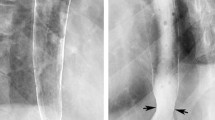Summary
The roentgenographic investigation of the two gastroscopic examinations taken for the purpose of revealing orientation of the gastroscope in the esophagus and stomach is shown in the accompanying photographs.
The present day gastroscopic examination by the flexible Cameron-Schindler gastroscope does not subject the patient to any appreciable discomfort or risk, if the contra-indications and proper preparation of the patient is observed. The greatest degree of flexion of the gastroscope occurs in the esophagus (10°) and to a lesser degree (5°) in the fundus of the stomach, due to the action of the hiatus esophagus and cardia. The cardia and lower pole of the stomach seems to be very elastic and adjusts itself to the slightest pressure of the scope without showing any undue stress or strain. The shaft of the scope is essentially straight throughout the midportion of the stomach and lies in close apposition to the posterior wall.
The reason for the blind spots or areas of the stomach as seen gastroscopically is explained by the oblique angle of vision or short focusing distance. These can be minimized in some instances by the regulation of air in the stomach, and by manipulation of the instrument and patient. These blind areas are relatively unimportant in most cases gastroscoped, but the reason for gastroscopic failure in a few. Unless there is some modification of the present type of flexible gastroscope it will be impossible to entirely eradicate these blind areas.
It is naturally of great interest and great concern to all engaged in gastroscopy to be able to visualize the entire gastric mucosa and with a minimum of risk.
In the past the pictorial action of the gastroscope was based on schematic representations and did not depict exactly what was occurring. What was felt and seen by the gastroscope gave us our orientation entirely. This study was therefore undertaken in the hope that it would facilitate a better understanding of what occurs to the gastroscope, and its effect on the anatomical structures wherein it lies.
Similar content being viewed by others
Author information
Authors and Affiliations
Rights and permissions
About this article
Cite this article
Hufford, A.R., Stonehouse, G.G. Orientation of the gastroscope by Roentgenograms. American Journal of Digestive Diseases 12, 61–64 (1945). https://doi.org/10.1007/BF02998253
Received:
Issue Date:
DOI: https://doi.org/10.1007/BF02998253




